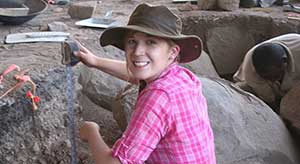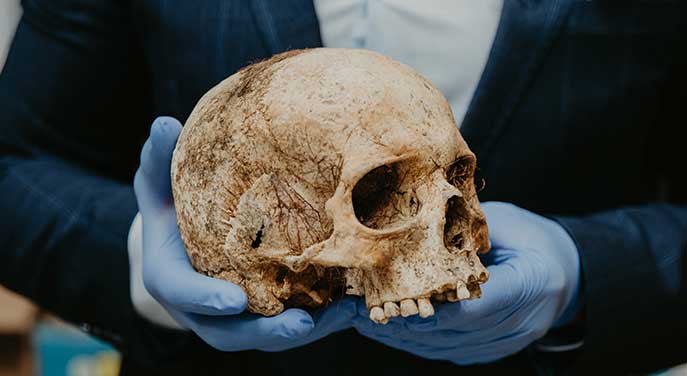When Elizabeth Sawchuk started getting involved in ancient DNA research as part of her archeological research in Africa, she turned to colleagues for advice on sampling DNA from ancient human remains.
As a post-doctoral fellow at Stony Brook University, she felt it was crucial to get it right.
“They’re extremely precious,” said Sawchuk, now a Banting post-doctoral fellow in the Department of Anthropology at the University of Alberta.
“Human remains provide a unique source of information on the past that we can’t access through other archeological materials. More importantly, they are people who used to be alive and who may have descendants today who care a lot about them. … Once you destroy the bone, you can’t get it back.”
Sawchuk was dismayed to find there were no universal protocols for sampling ancient human remains. Most literature focused on what bones to sample and how to minimize contamination, not how to avoid unnecessary destruction of skeletal material.
For Sawchuk – a bioarcheologist who studies ancient human teeth, a preferred element for DNA sampling – this was concerning.
“After seeing some skeletal collections where samples were taken, I thought, ‘This isn’t the way it should be. This is too much taken, too much destroyed.’”
So Sawchuk published her own thoughts on ethical guidelines in 2018, along with fellow archeologist Mary Prendergast at Saint Louis University Madrid, focusing on how to select ancient DNA samples with minimal destruction.

Elizabeth Sawchuk doing fieldwork in Tanzania. Sawchuk is the only Canadian co-author on an international project that resulted in newly published global guidelines for ethically sampling DNA in ancient remains. (Photo: Supplied)
That paper was cited extensively, resulting in an invitation to join an international team of 64 researchers from 31 countries who were developing a set of global guidelines on ancient DNA. The guidelines appear for the first time today in the journal Nature.
Sawchuk is the only co-author from Canada.
The dearth of ethical guidelines for DNA sampling is not surprising, said Sawchuk, since the “ancient DNA revolution” is less than two decades old.
“The first fully sequenced ancient DNA genome was published in 2010, the year I conducted my first bioarcheological excavations in Tanzania as a U of A master’s student,” she noted. “It has been amazing to watch this field grow rapidly over the past decade.”
The number of fully sequenced ancient individuals went from zero in 2009 to more than 6,000 published today – exponential growth in this area of research.
While there has been progress in developing ethical guidelines to accompany this work, most have focused on North American contexts, Sawchuk explained.
“What this paper does is looks at global case studies to understand the full breadth of potential ethical issues in ancient DNA research and figure out what the common principles are that work anywhere in the world.”
The Nature article outlines “strong and universally applicable” best practices for studying the DNA of ancient individuals while ensuring sensitivity to diverse stakeholder groups. They include:
- abiding by all regulations in the places where they work and from which the human remains originate
- preparing a detailed plan before beginning any study
- minimizing damage to human remains
- ensuring data are made available following publication to allow critical re-examination of scientific findings
- engaging with other stakeholders and ensuring respect and sensitivity to stakeholder perspectives
First and foremost, the guidelines aim to make sure all stakeholders relevant to a project – which can include Indigenous and descendant communities, museum curators and others with connections to the ancient individuals being studied – are engaged in research from the very beginning.
Also crucial is that data are made available to other scientists after research is complete for the purpose of replication, said Sawchuk, “so we don’t have to destroy more bones than we need to, and can avoid sampling the same individuals and sites.”
She added the guidelines will be published open access so they are freely available to curators, geneticists, archeologists and members of the public around the world. Co-authors on the paper have also translated it into multiple languages to help get the message out.
“These guidelines represent a turning point in the ancient DNA field,” Sawchuk said, “and I do believe they will have a long-lasting positive impact.”
| By Geoff McMaster
Submitted by the University of Alberta’s Folio online magazine. The University of Alberta is a Troy Media Editorial Content Provider Partner.
© Troy Media
Troy Media is an editorial content provider to media outlets and its own hosted community news outlets across Canada.


